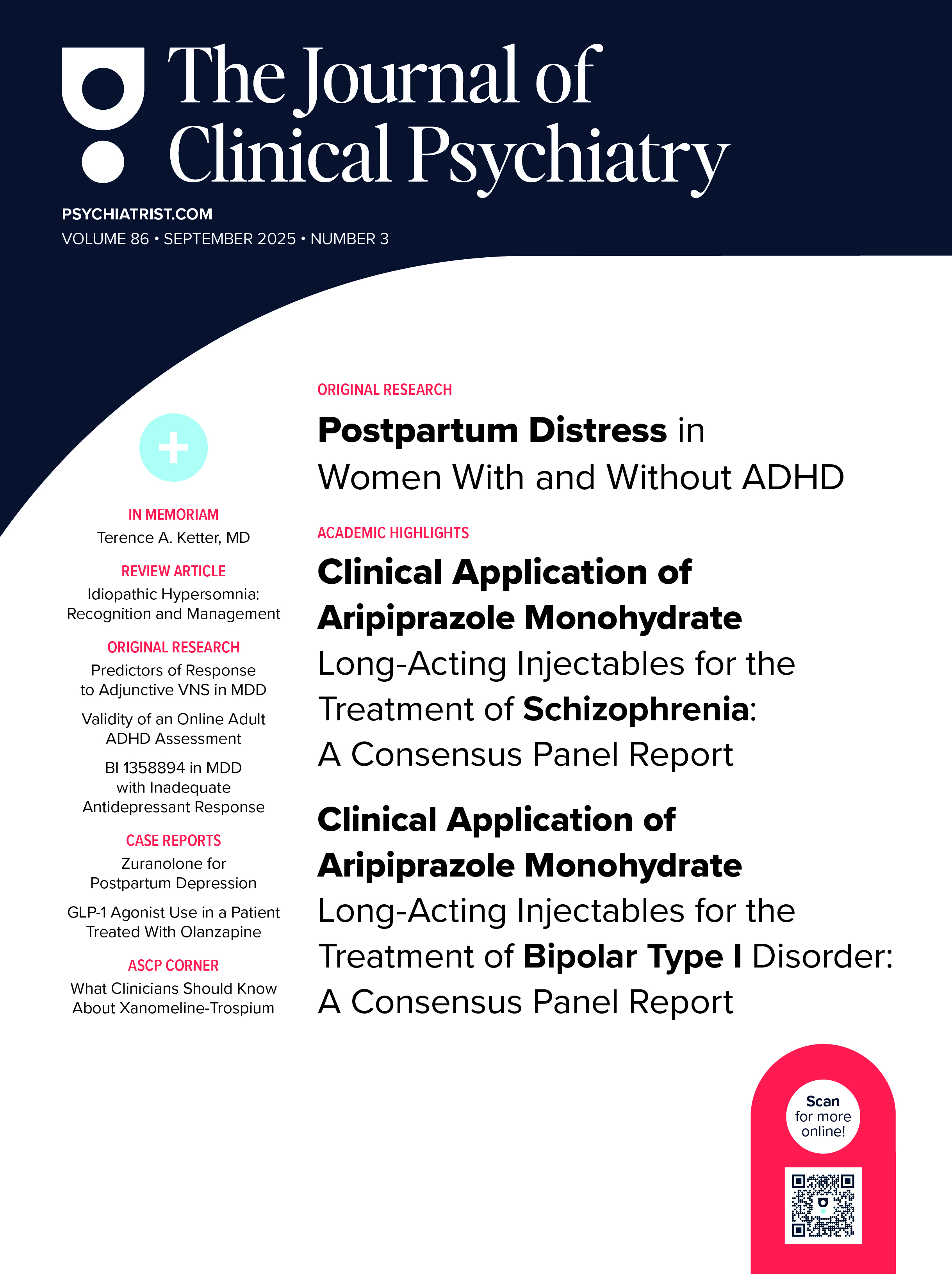ABSTRACT
Objective: High-deductible health plans paired with health savings accounts (HSA-HDHPs) require substantial out-of-pocket spending for most services, including medications. We examined effects of HSA-HDHPs on medication out-of-pocket spending and use among people with bipolar disorder.
Methods: This quasi-experimental study used claims data for January 2003 through December 2014. We studied a national sample of 348 members with bipolar disorder (defined based on International Classification of Diseases, 9th Revision), aged 12 to 64 years, who were continuously enrolled for 1 year in a low-deductible plan (≤ $500) then 1 year in an HSA-HDHP (≥ $1,000) after an employer-mandated switch. HSA-HDHP members were matched to 4,087 contemporaneous controls who remained in low-deductible plans. Outcome measures included out-of-pocket spending and use of bipolar disorder medications, non-bipolar psychotropics, and all other medications.
Results: Mean pre-to-post out-of-pocket spending per person for bipolar disorder medications increased by 149.7% among HSA-HDHP versus control members (95% confidence interval [CI], 109.9% to 189.5%). Specifically, out-of-pocket spending increased for antipsychotics (220.9% [95% CI, 150.0% to 291.8%]) and anticonvulsants (109.6% [95% CI, 67.3% to 152.0%]). Both higher-income and lower-income HSA-HDHP members experienced increases in out-of-pocket spending for bipolar disorder medications (135.2% [95% CI, 86.4% to 184.0%] and 164.5% [95% CI, 100.9% to 228.1%], respectively). We did not detect statistically significant changes in use of bipolar disorder medications, non-bipolar psychotropics, or all other medications in this study population of HSA-HDHP members.
Conclusions: HSA-HDHP members with bipolar disorder experienced substantial increases in out-of-pocket burdens for medications essential for their functioning and well-being. Although HSA-HDHPs were not associated with detectable reductions in medication use, high out-of-pocket costs could cause financial strain for lower-income enrollees.
Members Only Content
This full article is available exclusively to Professional tier members. Subscribe now to unlock the HTML version and gain unlimited access to our entire library plus all PDFs. If you’re already a subscriber, please log in below to continue reading.
References (49)

- Kaiser Family Foundation. 2020 Employer Health Benefits Survey. KFF website. https://www.kff.org/health-costs/report/2020-employer-health-benefits-survey/. Published October 8, 2020. Accessed July 12, 2021.
- Dolan R, Fronstin P, Claxton G, et al. Health Policy Brief: High-Deductible Health Plans. Health Affairs and Robert Wood Johnson Foundation; 2016. Health Affairs website. https://www.healthaffairs.org/do/10.1377/hpb20160204.950878/full/. Accessed August 24, 2020.
- Kaiser Family Foundation. Cost-Sharing for Plans Offered in the Federal Marketplace, 2014–2021. KFF website. https://www.kff.org/slideshow/cost-sharing-for-plans-offered-in-the-federal-marketplace/. Published January 15, 2021. Accessed July 12, 2021.
- Health Savings Accounts and Other Tax-Favored Health Plans. IRS website. https://www.irs.gov/pub/irs-pdf/p969.pdf. Accessed July 12, 2021.
- Internal Revenue Service. Additional Preventive Care Benefits Permitted to Be Provided by a High Deductible Health Plan Under § 223. Internal Revenue Service; 2019. IRS website. https://www.irs.gov/pub/irs-drop/n-19-45.pdf. Accessed August 24, 2020.
- Merikangas KR, Akiskal HS, Angst J, et al. Lifetime and 12-month prevalence of bipolar spectrum disorder in the National Comorbidity Survey replication. Arch Gen Psychiatry. 2007;64(5):543–552. PubMed CrossRef
- Judd LL, Akiskal HS, Schettler PJ, et al. A prospective investigation of the natural history of the long-term weekly symptomatic status of bipolar II disorder. Arch Gen Psychiatry. 2003;60(3):261–269. PubMed CrossRef
- Judd LL, Akiskal HS, Schettler PJ, et al. The long-term natural history of the weekly symptomatic status of bipolar I disorder. Arch Gen Psychiatry. 2002;59(6):530–537. PubMed CrossRef
- Hirschfeld RMA, Bowden CL, Gitlin MJ, et al. Practice Guideline for the Treatment of Patients With Bipolar Disorder (Revision). Focus. 2003;1(1):64–110. CrossRef
- Suppes T, Dennehy EB, Hirschfeld RM, et al; Texas Consensus Conference Panel on medication treatment of bipolar disorder. The Texas implementation of medication algorithms: update to the algorithms for treatment of bipolar I disorder. J Clin Psychiatry. 2005;66(7):870–886. PubMed CrossRef
- Bauer MS, Callahan AM, Jampala C, et al. Clinical practice guidelines for bipolar disorder from the Department of Veterans Affairs. J Clin Psychiatry. 1999;60(1):9–21. PubMed CrossRef
- Geddes JR, Burgess S, Hawton K, et al. Long-term lithium therapy for bipolar disorder: systematic review and meta-analysis of randomized controlled trials. Am J Psychiatry. 2004;161(2):217–222. PubMed CrossRef
- Swann AC. Long-term treatment in bipolar disorder. J Clin Psychiatry. 2005;66(suppl 1):7–12. PubMed
- Tohen M, Greil W, Calabrese JR, et al. Olanzapine versus lithium in the maintenance treatment of bipolar disorder: a 12-month, randomized, double-blind, controlled clinical trial. Am J Psychiatry. 2005;162(7):1281–1290. PubMed CrossRef
- Madden JM, Araujo-Lane C, Foxworth P, et al. Experiences of health care costs among people with employer-sponsored insurance and bipolar disorder. J Affect Disord. 2021;281:41–50. PubMed CrossRef
- Soumerai SB, McLaughlin TJ, Ross-Degnan D, et al. Effects of a limiting Medicaid drug-reimbursement benefits on the use of psychotropic agents and acute mental health services by patients with schizophrenia. N Engl J Med. 1994;331(10):650–655. PubMed CrossRef
- Soumerai SB, Ross-Degnan D, Avorn J, et al. Effects of Medicaid drug-payment limits on admission to hospitals and nursing homes. N Engl J Med. 1991;325(15):1072–1077. PubMed CrossRef
- Soumerai SB, Avorn J, Ross-Degnan D, et al. Payment restrictions for prescription drugs under Medicaid. Effects on therapy, cost, and equity. N Engl J Med. 1987;317(9):550–556. PubMed CrossRef
- Lu CY, Adams AS, Ross-Degnan D, et al. Association between prior authorization for medications and health service use by Medicaid patients with bipolar disorder. Psychiatr Serv. 2011;62(2):186–193. PubMed CrossRef
- Lu CY, Soumerai SB, Ross-Degnan D, et al. Unintended impacts of a Medicaid prior authorization policy on access to medications for bipolar illness. Med Care. 2010;48(1):4–9. PubMed CrossRef
- Gibson TB, Jing Y, Kim E, et al. Cost-sharing effects on adherence and persistence for second-generation antipsychotics in commercially insured patients. Manag Care. 2010;19(8):40–47. PubMed
- Madden JM, Adams AS, LeCates RF, et al. Changes in drug coverage generosity and untreated serious mental illness: transitioning from Medicaid to Medicare Part D. JAMA Psychiatry. 2015;72(2):179–188. PubMed CrossRef
- Wharam JF, Wallace J, LeCates R, et al. Out-of-pocket spending inequity among high-deductible health plan members with bipolar disorder [epub ahead of print]. J Gen Intern Med. 2021. CrossRef
- Wharam JF, Zhang F, Wallace J, et al. Vulnerable and less vulnerable women in high-deductible health plans experienced delayed breast cancer care. Health Aff (Millwood). 2019;38(3):408–415. PubMed CrossRef
- Wharam JF, Lu CY, Zhang F, et al. High-deductible insurance and delay in care for the macrovascular complications of diabetes. Ann Intern Med. 2018;169(12):845–854. PubMed CrossRef
- Wharam JF, Zhang F, Eggleston EM, et al. Effect of high-deductible insurance on high-acuity outcomes in diabetes: a Natural Experiment for Translation in Diabetes (NEXT-D) Study. Diabetes Care. 2018;41(5):940–948. PubMed CrossRef
- Wharam JF, Busch AB, Madden J, et al. Effect of high-deductible insurance on health care use in bipolar disorder. Am J Manag Care. 2020;26(6):248–255. PubMed CrossRef
- Lu CY, Busch AB, Zhang F, et al. The impact of high-deductible health plans on medication use among individuals with bipolar disorder. Psychiatr Serv. 2021;72(8):926–934. PubMed CrossRef
- Iacus SM, King G, Porro G. Multivariate matching methods that are monotonic imbalance bounding. J Am Stat Assoc. 2011;106(493):345–361. CrossRef
- Iacus SM, King G, Porro G. Causal inference without balance checking: coarsened exact matching. Polit Anal. 2012;20(1):1–24. CrossRef
- Schreyögg J, Stargardt T, Tiemann O. Costs and quality of hospitals in different health care systems: a multi-level approach with propensity score matching. Health Econ. 2011;20(1):85–100. PubMed CrossRef
- St. Clair T, Cook TD, Hallberg K. Examining the internal validity and statistical precision of the comparative interrupted time series design by comparison with a randomized experiment. Am J Eval. 2014;35(3):311–327. CrossRef
- Hallberg K, Cook TD, Steiner PM, et al. Pretest measures of the study outcome and the elimination of selection bias: evidence from three within study comparisons. Prev Sci. 2018;19(3):274–283. PubMed CrossRef
- US Census Bureau. American Community Survey (ACS). The United States Census Bureau website. https://www.census.gov/programs-surveys/acs. Accessed December 6, 2019.
- Yang D, Dalton JE. A unified approach to measuring the effect size between two groups using SAS. In: Statistics and Data Analysis. Vol 335–2012.; 2012:6. Semantic Scholar website. https://www.semanticscholar.org/paper/A-unified-approach-to-measuring-the-effect-size-two-Yang-Dalton/6cf4bd36ca4c90006a5d6563f646a391c255581b. Accessed February 15, 2022.
- Cook TD, Campbell DT, Shadish WR. Experimental and Quasi-Experimental Designs for Generalized Causal Inference. Houghton Mifflin; 2001.
- Zeger SL, Liang K-Y. Longitudinal data analysis for discrete and continuous outcomes. Biometrics. 1986;42(1):121–130. PubMed CrossRef
- Newhouse JP, Insurance Experiment Group. Free for All? Lessons From the RAND Health Insurance Experiment. Harvard University Press; 1993.
- Lee B. Affordability Concerns Lead More Employers to “Future-Focused” Strategies. Mercer website. https://www.mercer.com/newsroom/mercer-national-survey-affordability-concerns-lead-more-employers-to-future-focused-strategies-to-manage-health-benefit-cost.html. Published October 30, 2018. Accessed August 24, 2020.
- Reynolds C, Rudder L. Consumer-Directed Health Plans: Pharmacy Benefits & “Better Practices” | National Pharmaceutical Council. National Pharmaceutical Council website. https://www.npcnow.org/publication/consumer-directed-health-plans-pharmacy-benefits-better-practices. Published September 30, 2014. Accessed August 24, 2020.
- Gabel JR, Whitmore H, Green M, et al. Consumer Cost-Sharing in Marketplace vs Employer Health Insurance Plans, 2015 | Commonwealth Fund. The Commonwealth Fund website. https://www.commonwealthfund.org/publications/issue-briefs/2015/dec/consumer-cost-sharing-marketplace-vs-employer-health-insurance. Published December 21, 2015. Accessed August 24, 2020.
- Parker G, Fletcher K, McCraw S, et al. Identifying antecedent and illness course variables differentiating bipolar I, bipolar II and unipolar disorders. J Affect Disord. 2013;148(2–3):202–209. PubMed CrossRef
- Mantere O, Suominen K, Valtonen HM, et al. Differences in outcome of DSM-IV bipolar I and II disorders. Bipolar Disord. 2008;10(3):413–425. PubMed CrossRef
- Krieger N. Overcoming the absence of socioeconomic data in medical records: validation and application of a census-based methodology. Am J Public Health. 1992;82(5):703–710. PubMed CrossRef
- Krieger N, Chen JT, Waterman PD, et al. Race/ethnicity, gender, and monitoring socioeconomic gradients in health: a comparison of area-based socioeconomic measures–the public health disparities geocoding project. Am J Public Health. 2003;93(10):1655–1671. PubMed CrossRef
- Ethnic Technologies. Ethnic Technologies website. https://www.ethnictechnologies.com/. Accessed October 24, 2018.
- Fiscella K, Fremont AM. Use of geocoding and surname analysis to estimate race and ethnicity. Health Serv Res. 2006;41(4 Pt 1):1482–1500. PubMed CrossRef
- The Johns Hopkins ACG System, Installation and Usage Guide, Version 10.0. John Hopkins University; 2013:266. Hopkins ACG website. https://www.hopkinsacg.org/document/acg-system-version-10-0-installation-and-usage-guide/. Accessed February 15, 2022.
- Reid RJ, Roos NP, MacWilliam L, et al. Assessing population health care need using a claims-based ACG morbidity measure: a validation analysis in the Province of Manitoba. Health Serv Res. 2002;37(5):1345–1364. PubMed CrossRef




